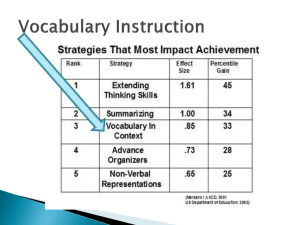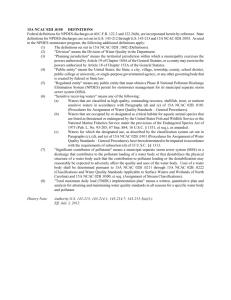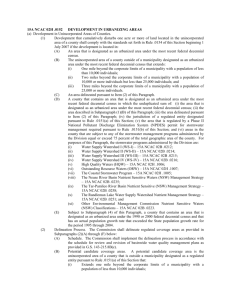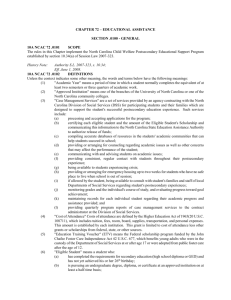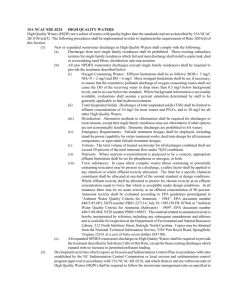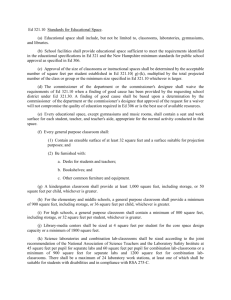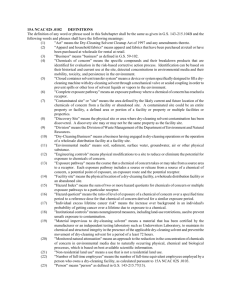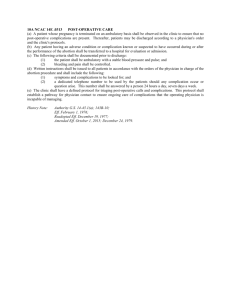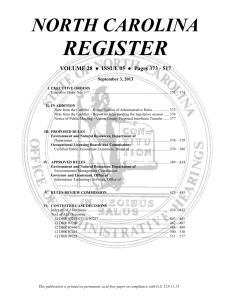SUBCHAPTER 60C ‑ FOREST PRACTICES GUIDELINES
advertisement
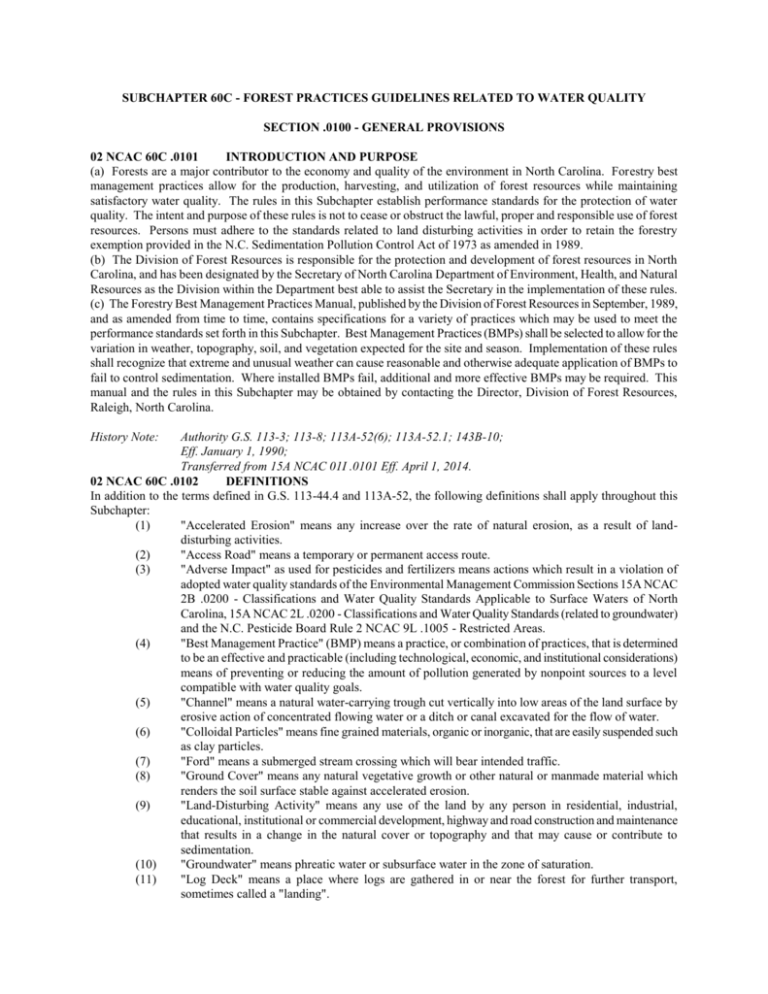
SUBCHAPTER 60C - FOREST PRACTICES GUIDELINES RELATED TO WATER QUALITY SECTION .0100 - GENERAL PROVISIONS 02 NCAC 60C .0101 INTRODUCTION AND PURPOSE (a) Forests are a major contributor to the economy and quality of the environment in North Carolina. Forestry best management practices allow for the production, harvesting, and utilization of forest resources while maintaining satisfactory water quality. The rules in this Subchapter establish performance standards for the protection of water quality. The intent and purpose of these rules is not to cease or obstruct the lawful, proper and responsible use of forest resources. Persons must adhere to the standards related to land disturbing activities in order to retain the forestry exemption provided in the N.C. Sedimentation Pollution Control Act of 1973 as amended in 1989. (b) The Division of Forest Resources is responsible for the protection and development of forest resources in North Carolina, and has been designated by the Secretary of North Carolina Department of Environment, Health, and Natural Resources as the Division within the Department best able to assist the Secretary in the implementation of these rules. (c) The Forestry Best Management Practices Manual, published by the Division of Forest Resources in September, 1989, and as amended from time to time, contains specifications for a variety of practices which may be used to meet the performance standards set forth in this Subchapter. Best Management Practices (BMPs) shall be selected to allow for the variation in weather, topography, soil, and vegetation expected for the site and season. Implementation of these rules shall recognize that extreme and unusual weather can cause reasonable and otherwise adequate application of BMPs to fail to control sedimentation. Where installed BMPs fail, additional and more effective BMPs may be required. This manual and the rules in this Subchapter may be obtained by contacting the Director, Division of Forest Resources, Raleigh, North Carolina. History Note: Authority G.S. 113-3; 113-8; 113A-52(6); 113A-52.1; 143B-10; Eff. January 1, 1990; Transferred from 15A NCAC 01I .0101 Eff. April 1, 2014. 02 NCAC 60C .0102 DEFINITIONS In addition to the terms defined in G.S. 113-44.4 and 113A-52, the following definitions shall apply throughout this Subchapter: (1) "Accelerated Erosion" means any increase over the rate of natural erosion, as a result of landdisturbing activities. (2) "Access Road" means a temporary or permanent access route. (3) "Adverse Impact" as used for pesticides and fertilizers means actions which result in a violation of adopted water quality standards of the Environmental Management Commission Sections 15A NCAC 2B .0200 - Classifications and Water Quality Standards Applicable to Surface Waters of North Carolina, 15A NCAC 2L .0200 - Classifications and Water Quality Standards (related to groundwater) and the N.C. Pesticide Board Rule 2 NCAC 9L .1005 - Restricted Areas. (4) "Best Management Practice" (BMP) means a practice, or combination of practices, that is determined to be an effective and practicable (including technological, economic, and institutional considerations) means of preventing or reducing the amount of pollution generated by nonpoint sources to a level compatible with water quality goals. (5) "Channel" means a natural water-carrying trough cut vertically into low areas of the land surface by erosive action of concentrated flowing water or a ditch or canal excavated for the flow of water. (6) "Colloidal Particles" means fine grained materials, organic or inorganic, that are easily suspended such as clay particles. (7) "Ford" means a submerged stream crossing which will bear intended traffic. (8) "Ground Cover" means any natural vegetative growth or other natural or manmade material which renders the soil surface stable against accelerated erosion. (9) "Land-Disturbing Activity" means any use of the land by any person in residential, industrial, educational, institutional or commercial development, highway and road construction and maintenance that results in a change in the natural cover or topography and that may cause or contribute to sedimentation. (10) "Groundwater" means phreatic water or subsurface water in the zone of saturation. (11) "Log Deck" means a place where logs are gathered in or near the forest for further transport, sometimes called a "landing". (12) (13) (14) (15) (16) (17) (18) (19) (20) (18) History Note: "Mill Site" means any place where forest products are stored, altered, or processed. "Permanently Stabilized" means the site is protected to the state at which no further accelerated erosion is expected to occur from the forestry activities. "Pesticides" means a chemical used to kill pests. The term includes insecticides, fungicides, herbicides, and rodenticides. "Site Preparation" means a forest activity to prepare the site for reforestation. "Skid Trail" means a temporary pathway principally used to drag or transport felled trees or logs or other material to a landing. "Stream" means a body of concentrated flowing water in a natural low area of the land surface. (a) "Ephemeral stream" means a stream that flows only during and for short periods following precipitation and flows in low areas that may or may not have a well-defined channel. (b) "Intermittent stream" means a stream that flows only during wet periods of the year (30-90 percent of the time) and flows in a continuous well-defined channel. (c) "Perennial stream" means a stream that flows throughout a majority of the year (greater than 90 percent of the time) and flows in a well-defined channel. "Streamside Management Zone (SMZ)" means an area along both sides of intermittent and perennial streams and perennial waterbodies where extra precaution is used in carrying out forest practices in order to protect water quality. "Visible Sediment" means solid particulate matter, both mineral and organic, which can be seen with the unaided eye that has been or is being transported by water, air, gravity, or ice from its site of origin. This does not normally include colloidal sized particles. "Waterbody" means a natural or man-made basin that stores water, not including jurisdictional wetlands or beaver ponds. "Working Days" means days exclusive of Saturdays and Sundays during which weather conditions or soil conditions permit land-disturbing activity to be undertaken. Authority G.S. 113-44.4; 113A-52; 113A-52.1; Eff. January 1, 1990; Transferred from 15A NCAC 01I .0102 Eff. April 1, 2014. SECTION .0200 - PERFORMANCE STANDARDS 02 NCAC 60C .0201 STREAMSIDE MANAGEMENT ZONE (a) A streamside management zone (SMZ) shall be established and maintained along the margins of intermittent and perennial streams and perennial waterbodies. The SMZ shall be of sufficient width to confine within the SMZ visible sediment resulting from accelerated erosion. (b) Ground cover, or other means, within the SMZ shall be sufficient to restrain accelerated erosion. (c) Access roads, skid trails, except as provided in Rule .0203 of this Section, logging decks and mill sites shall be placed outside of SMZs. When barriers such as property lines or limiting land features prohibit the location of any of these outside of SMZs, they can be located within the SMZs. When located within SMZs they shall have effective erosion control and sediment control structures or measures installed to restrain accelerated erosion and prevent visible sediment from entering intermittent or perennial streams or perennial waterbodies. History Note: Authority G.S. 113A-52.1; Eff. January 1, 1990; Transferred from 15A NCAC 01I .0201 Eff. April 1, 2014. 02 NCAC 60C .0202 PROHIBITION OF DEBRIS ENTERING STREAMS AND WATERBODIES Stream obstruction and the impediment of stream flow and/or degradation of water quality shall be prevented by keeping debris from construction, harvesting, mill site residue, and site preparation out of intermittent and perennial streams and perennial waterbodies. History Note: Authority G.S. 77-13; 77-14; 113A-52.1; Eff. January 1, 1990; Transferred from 15A NCAC 01I .0202 Eff. April 1, 2014. 02 NCAC 60C .0203 ACCESS ROAD AND SKID TRAIL STREAM CROSSINGS Stream crossings shall be avoided when possible. Access roads and skid trails which must cross intermittent or perennial streams or perennial waterbodies shall be constructed so as to minimize the amount of sediment that enters the streams because of the construction. These crossings shall be installed so that: (1) stream flow will not be obstructed or impeded; (2) no stream channel or perennial waterbody shall be used as an access road or skid trail; (3) crossings are provided with effective structures or ground cover to protect the banks and channel from accelerated erosion; (4) they shall have sufficient water control devices to collect and divert surface flow from the access road or skid trail into undisturbed areas or other control structures to restrain accelerated erosion and prevent visible sediment from entering intermittent and perennial streams; and (5) ground cover, or other means, sufficient to prevent visible sediment from entering intermittent and perennial streams and perennial waterbodies shall be provided within ten working days of initial disturbance and will be maintained until the site is permanently stabilized. History Note: Authority G.S. 113A-52.1; Eff. January 1, 1990; Transferred from 15A NCAC 01I .0203 Eff. April 1, 2014. 02 NCAC 60C .0204 ACCESS ROAD ENTRANCES Access road entrances intersecting public highways shall be constructed and maintained with measures, devices or techniques effective to prevent excessive soil and other debris from being carried to and deposited on the highway to the extent that sedimentation problems will result. History Note: Authority G.S. 113A-52.1; Eff. January 1, 1990; Transferred from 15A NCAC 01I .0204 Eff. April 1, 2014. 02 NCAC 60C .0205 PROHIBITION/WASTE ENTERING STREAMS/WATERBODIES/GROUNDWATER Measures shall be taken to prevent equipment servicing waste, petroleum, fertilizers or other chemical waste from entering streams, perennial waterbodies, and groundwater which result in a violation of an adopted water quality standard of the Environmental Management Commission in Sections 15A NCAC 02B .0200 - Classifications and Water Quality Standards Applicable to Surface Waters of North Carolina, and 15A NCAC 02L .0200 - Classifications and Water Quality Standards (related to groundwater). History Note: Authority G.S. 113A-52.1; 143-214.1; Eff. January 1, 1990; Transferred from 15A NCAC 01I .0205 Eff. April 1, 2014. 02 NCAC 60C .0206 PESTICIDE APPLICATION Application of pesticides shall be limited to those labeled for that intended use, shall be used in accordance with labeling and rules adopted by the N.C. Pesticide Board as set forth in 2 NCAC 9L .1005, Restricted Areas, and applied in a manner to prevent adverse impacts on water quality. History Note: Authority G.S. 113A-52.1; 143-214.1; 143-458; Eff. January 1, 1990; Transferred from 15A NCAC 01I .0206 Eff. April 1, 2014. 02 NCAC 60C .0207 FERTILIZER APPLICATION When used, fertilizers shall be applied in a manner to prevent adverse impacts on water quality. History Note: Authority G.S. 113A-52.1; 143-214.1; Eff. January 1, 1990; Transferred from 15A NCAC 01I .0207 Eff. April 1, 2014. 02 NCAC 60C .0208 STREAM TEMPERATURE Adequate shade within SMZs associated with natural perennial streams shall be retained to protect those streams from adverse temperature fluctuations which result in a violation of an adopted water quality standard of the Environmental Management Commission as contained in Rule 15A NCAC 02B .0211 - Fresh Surface Water Classifications and Standards. History Note: Authority G.S. 113A-52.1; 143-214.1; Eff. January 1, 1990; Transferred from 15A NCAC 01I .0208 Eff. April 1, 2014. 02 NCAC 60C .0209 REHABILITATION OF PROJECT SITE Areas on the project site that have the potential for accelerated erosion, resulting in concentrated flow directly entering an intermittent or perennial stream or perennial waterbody, shall be provided with ground cover or other means of adequate sedimentation control within 30 working days after ceasing any phase of an operation or beginning a period of inactivity. Treatment and maintenance of those areas shall be sufficient to restrain accelerated erosion and prevent visible sediment from entering intermittent and perennial streams and perennial waterbodies until the site is permanently stabilized. History Note: Authority G.S. 113A-52.1; Eff. January 1, 1990; Transferred from 15A NCAC 01I .0209 Eff. April 1, 2014.
